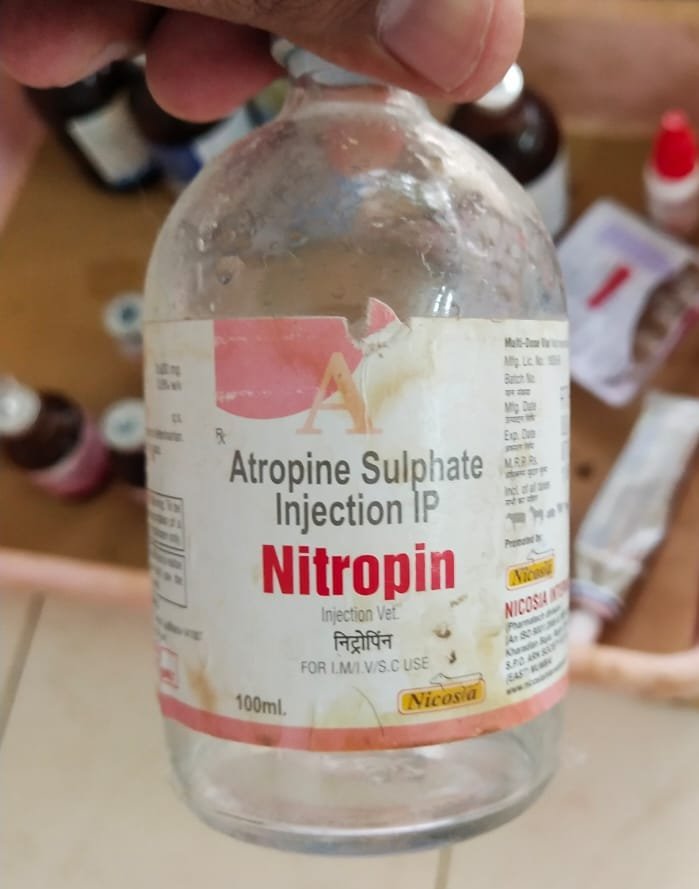TABLE OF CONTENTS
Atropine Sulphate
Atropine is a natural Anticholinergic (Parasympatholytic) and Muscarinic receptor antagonists agent that is present in Atropa belladonna leaves and in some other plants of the Solanaceae family.
Group
Atropine is grouped in Anticholinergic (Parasympatholytic) and Muscarinic receptor antagonists agent.
Mechanism of Action
Atropine blocks acetylcholine (ACh) at muscarinic receptors and produce Antivagal effects.
Dose Rates
- Dogs: 0.02 mg/kg to 0.04 mg/kg q6hr IV , SC, IM
- Cats: 0.02 mg/kg to 0.04 mg/kg q6hr IV , SC, IM
- Horses: 0.02 mg/kg to 0.04 mg/kg q6hr IV , SC, IM
- Pigs: 0.02 mg/kg to 0.04 mg/kg q6hr IV , SC, IM
- Sheep and Goats: 0.02 mg/kg to 0.04 mg/kg q6hr IV , SC, IM
- Cattle: 0.02 mg/kg to 0.04 mg/kg q6hr IV , SC, IM
For organophosphate and carbamate poisoning treatment in dogs and cats, a dose of atropine can be given up to 0.5 mg/kg, and for organophosphate and carbamate poisoning in horses, pigs, and ruminants (cattle, sheep, and goats), a dose of atropine can be given up to 0.04 mg/kg.
Indications
- Atropine used as Preanaesthetic
- Decrease Gastro intestinal motility (Antispasmodic)
- Decrease Gastro intestinal secretions
- Decrease respiratory tract secretions
- Increase heart rate (Tachycardia)
- Used during cardiac arrest
- Antidote for organophosphate and carbamate poisoning
- Mydriasis
- Single dose in Relieve broncho-constriction in horses (equine asthma syndrome)
- Cardiac resuscitation
Contraindications
- In case of ileus and Constipation
- Glaucoma
- Animal with Tachycardia
Interactions
- Atropine antagonizes effects of cholinergic drugs when administered together
Adverse effects
- Xerostomia (Dry mouth)
- Ileus and Constipation
- Tachycardia
- Retention of Urine
Toxicity
Atropine is present in Atropa belladonna leaves.
Herbivores are more resistant than carnivores, Certain strains of rabbits are resistant to a diet of belladonna leaves, (as the liver contains the enzyme atropinase) although eating their meat may be toxic if eaten by dogs, cats or humans.
Signs of Atropine toxicity includes dry mouth, thirst, constipation, mydriasis, tachycardia, restlessness, delirium, ataxia, convulsions, respiratory depression and respiratory failure leads to death. When urine from the animal suspected of atropine poisoning is instilled in the eye of a cat, dilatation can be noticed.
Antidote of Atropine is Physostigmine.
Preparations
Atropine sulphate injections are parenteral preparations available, and these are used in animals.
Various atropine injections are available; these are:
- Inj Morvel Atropine Sulphate (100mL vial with 1mg/mL concentration)
- Inj. Atropin-Vet (30ml and 100mL vial with 1mg/mL concentration)
- Inj. Nitropin (30mL and 100mL vial with 0.6mg/mL concentration)
- Inj. Atrorays (1mL ampoule with 0.6mg/mL concentration)
- Inj. Atropmed (1mL ampoule with 0.6mg/mL concentration)
- Inj. Atop (100mL vial with 0.6mg/mL concentration)
- Inj. Atromac (100mL vial with 0.6mg/mL concentration)
- Inj. Aropin-100 (100mL vial with 0.6mg/mL concentration)
- Inj. Atrosol GB (10, 30 and 100mL vial with 0.6mg/mL concentration)
More about Atropine Sulpahte for Animals

Information provided here may be subject to inaccuracies. Please consult a reputable textbook for verification before use. We welcome your feedback and suggestions for improvement via email at hello@vetscraft.com

